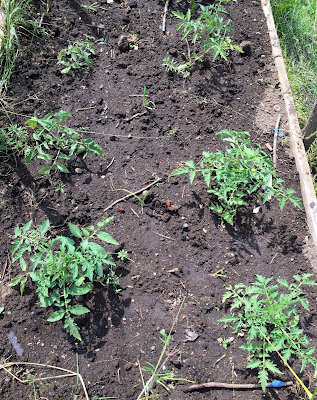 |
| Tomato Plants. 6.10.17 |
Today I planted the 4th batch, probably final batch, of
sweet corn seeds. The variety was Bodaceous, which I bought last fall at Fred Meyer on close out. I don't think I will try to keep sweet corn seeds any more, they are less able to remain viable with time. Still, one year old should be OK.
Bodaceous is a yellow sweet corn, SE type (sugary enhanced) - not the supersweet type, but remains sweet longer on the plant - matures in about 75 days, has improved disease resistance, and is well adapted to the Northwest. Since I'm not planning to save the seeds another year, I planted the entire packet in 4 rows, and will thin to a foot apart if germination turns out to be good.
I noted that a
blackberry plant -
Arapaho - had purple leaves. Researching that, it appears to be caused by phosphorus deficiency. I will need to find a supplement for that. In some cases, I read that plants with deficient magnesium in the soil, are not able to take up phosphorus. Since I know from soil test that my soil is magnesium, and probably not phosphorus, deficient, I will apply some
Epsom Salts, 2 tablespoons per 2 gallons of water, for more of my kitchen garden plants. When I did that for
Saijo Persimmon, the result was dark green leaves, instead of the usual pale green / yellow leaves. So I think it helped. I applied that amount of Epsom salts solution for the tomatoes, peppers, sweet corn, and chestnut tree saplings, then ran out. That kind of gets away from the concept of phosphorus deficiency, but phosphate was normal to high in my soil. Other side of yard, but that I what I have to go on for the time being.
I don't know if I blogged on this - I added another horticultural blackberry,
Triple Crown. My readings pointed me to this variety, tetraploid - as is
Prime Ark Freedom but I don't know about
Ebony King. Triple Crown is described as disease resistant, highly productive, and a delicious fruit that works well in Pacific NW. I bought the plant at a local nursery, already green and growing; bare-rooted it carefully, removed planting compost, and planted in the native soil of my garden. I protected from deer and rabbits, with chicken wire.
I read that primocanes should have the growing tip removed, with both primocane-bearing and floricane-bearing, varieties of blackberry, at around 3 feet tall. My brambles are young, and only two have primocanes that tall, so I tipped them. Tipping means the growing tip is snapped off by bending. That promotes growth of branches, resulting in much higher yield and stronger plants.


